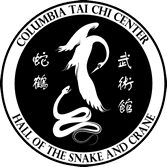No Fear: Martial Arts at Any Age with Traditional Tai Chi
By De Anna E. Beasley
“You’re not a spring chicken anymore. You’re more like a summer hen.”
Those were the words my Dad spoke to me as he carried my laundry up three flights of stairs to my apartment. I was too busy slowly and painfully easing my way up the stairs without aggravating my injured back. It was not a few hours ago I was in the emergency room after taking a pretty bad hit in a recreational soccer game that slammed me to the ground, causing my back to lock up.
I understood what my Dad was trying to say but I was incredulous nonetheless. I’ve always been an athletic individual and the idea that I physically couldn’t do something struck me as absurd even at that moment when I could barely stand on my feet. Besides, I was only 26 years old at the time of my injury; a far cry from a “summer hen”, in my opinion. I carefully laughed off my Dad’s overprotective concern and focused on getting one foot in front of the other.
Two years later, a hard collision with the goal keeper would severely sprain my knee and I realized—like so many other moments in my life—that my Dad was probably right. But I didn’t want to give up my active lifestyle even if I was willing to give up soccer after 20 years of competitive play. I had to figure out an alternative activity that would give me the physical challenge but also the sense of being part of a team.
Tai Chi Chuan
I first became aware of Tai Chi as a senior in college. I took part in a month long winter interim session where the Physics professors introduced Tai Chi philosophy and we learned a Yang-style form from a local Tai Chi instructor. It was the idea of moving meditation and balance that appealed to me, especially during that time when academics was particularly stressful. After graduation, I would seek out more opportunities to study the art. It was difficult in the beginning to find satisfying instruction. While I enjoyed learning the form and developing a meditative practice, I always felt something was missing. I knew that Tai Chi was practiced as a soft style martial art but it seemed everyone referred to that point as an interesting historical fact and not a current way of doing things. I couldn’t find anyone who taught Tai Chi as anything other than an art of relaxation. If I wanted more physical training, I had to look outside of Tai Chi.
Ego and Chaos
I thought the solution was to find a hard style like Karate or Taekwondo to compliment the little Tai Chi training I had at the time. I certainly found the physical challenge in most schools but a meditative practice was more of an afterthought than a conscious exercise. The target audience for most of these schools was young kids looking for fun and men seeking to become the next martial arts champion. So on one end I’m buffeted by the hyperactive energy of children throwing punches and kicks; on the other the ego of young, aspiring fighters. The experience was not ideal for me. I already had a competitive edge. I certainly did not need to nurture that quality however I liked learning the practical skills of self-defense while getting a solid workout. I knew well enough from previous experience that I needed a more mindful practice in calming the mind if I wanted to cultivate a healthy, positive outlook on life.
Hall of the Snake and Crane
After passing my qualifying exam in 2008, I became a PhD candidate in the biological sciences program at the University of South Carolina. Once again I was facing a challenging academic venture and needed a healthy means of coping with the stress. I remembered how much I enjoyed the Tai Chi classes during my undergraduate studies and decided to seek out classes in the area. A quick Google search led me to Columbia Tai Chi Center.
At the free class, my impression of Sifu Adams was that of a man who cared deeply for the traditional practice of the Tai Chi, taking the time to develop strong fundamentals through careful practice and meditation. Based on those qualities alone, I knew I wanted to study at his school, but when he mentioned the self-defense class, I realized I found a rare gem in Columbia!
The first class left me sore, exhilarated and looking forward to more. I was facing physical challenges that kept me engaged and gave me a sense of accomplishment when I finally got a move right. I also liked how inclusive the class was: retired military, former dancers, experienced martial artists, school teachers all had something to gain and contribute to the class. I was with like-minded adults who wanted to learn a practical, lifelong skill but not necessarily become the next great UFC fighter. We were all working together towards enhancing our Tai Chi practice through the application of its martial intent.
I still practice Tai Chi and self-defense today, especially now that I’ve finished school and am working towards developing my own research career. Practicing self-defense has instilled a sense of confidence and appreciation for a healthy and balanced lifestyle. Studying Tai Chi at the Columbia Tai Chi Center was by far the best decision I could have made for my overall happiness and well-being. It has given me life skills that will stay with me—even when I’m truly a “summer hen”.
– De Anna Beasley is a postdoctoral research scholar in ecology. She’s been practicing Tai Chi for six years.
